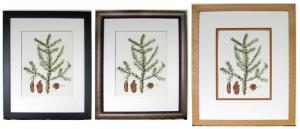Sale on canvas prints! Use code ABCXYZ at checkout for a special discount!

NEWSLETTER Fall 2009 No. 4
Greetings from the mountains of western Maine!
Most of September was devoted to framing my art to put in this month’s exhibit at Frost Farm Gallery, so this newsletter will have to be all about framing. For me the art-sharing is all one piece with the art-making, anyway. A large part of the retail price of any work of art is the frame, too. Hopefully you will come away from this with a little better appreciation of what is involved in the process from the artist’s point of view.
My husband Steve and I worked together on this project. This is the first time we have made our own frames. Steve did most of it: sawing and gluing the molding, cutting the glass and mats, and putting the hardware on the back. I did the design part, and helped with the assembly. It was a happy collaboration, and the results are stunning if I do say so myself.
I will start by saying that none of this would have happened without the help of our friend Dirk MacKnight. He is not only a superb photographer, but an able teacher. He gave us some good instruction on how to make frames, and then loaned us a lot of the equipment we needed. (You can see examples of his fine landscape photography by looking for him at http://www.flickr.com/photos/dirkphoto.)
The first consideration is the style of the frame. This body of artwork needed to be presented with great simplicity. I picked a plain ¾” wide wood molding in three different colors, natural oak, walnut brown, and black. I chose two colors of matboard, giving the works on watercolor paper a cool white mat to match the paper color, and the works on Stonehenge drawing paper a warmer white. We gave a few of the pieces a double mat, with a colored mat for the inner one.
It amazes me how much the colors of the mat and molding affect the appearance of the work. Adjacent colors “talk” to each other. Whatever color you pick for the frame will make that same color stand out more in the painting, so you have to choose carefully. You can’t take a weak painting and make it a great one just with the framing, but you sure can take a plain one and make it sing.
For example, here is the “Spruce Twig” watercolor framed in three different ways. The first frame is made from the black molding. The black looks dull and doesn’t do anything for the painting. The second is the walnut brown, which is better but still looks thin to me. The third is the way we ended up framing it, with a larger frame and mat and an inner second mat of a rich rusty brown color to bring out the colors in the spruce cones.
A second example is this watercolor of a crow feather. It is a wing feather that a crow dropped just for me last winter, and I keep it on my work desk to brush eraser crumbs off my drawings (art supplies form the sky!). You can see the way we framed it at the right, with a double mat, and you can see it with the black mat covered at the left. It is a very simple painting, but the narrow line of black from the inner mat is really what lifts it above the ordinary.
I really enjoyed the process of framing the paintings, even more than I thought I would. There is a real thrill to seeing a work framed and hung for the first time. I am looking forward very much to going back to my studio work now, and glad to know that whenever I need a frame we can produce one that will set the art off to its best advantage.
For those of you who are in Maine, my work will be at Frost Farm Gallery in Norway, Maine from now until the end of October. For more information, check out their website at www.FrostFarmGallery.com. It is a beautiful venue, and one that really complements this particular collection of paintings.
I have attached a file of the spruce twig here for you in the form of an art card. Art cards (or ACEO’s) are a collectible form of miniature art the same size as a baseball trading card. Print this one on good stiff photo paper, cut it out, and start your own collection, if you wish. I give you permission to print or reproduce this image as you choose.
For more information on “Swift River Treasures,” my artmaking process, or recent work, or to check out my blog, see my website at http://betsy-bell.fineartamerica.com. You can also search for me on fineartamerica.com as Betsy Gray Bell under the “Artists” button in the top menu bar. (The drop-down box under it has a search feature.) Fine Art America offers a print-on-demand service, matting, framing, and shipping, and fine art greeting cards as well.
There is time for making art, once you understand that it’s about making choices. (Ricë Freeman-Zachery, author of Creative Time and Space: Making Room for Making Art)
Thanks for joining me in the journey. I hope that you enjoy looking at the art as much as I have enjoyed making it! I would love to hear from you, too, so please do reply with comments. And next month I will be back to doing the naturalist thing again.
Betsy